This was published 3 years ago
Architect Rachel Neeson: from a commune to tragedy to the museum
By Shona Martyn
Architect Rachel Neeson is listing three special places where we could lunch. "My absolute favourite is Sean's Panorama in Bondi — my son was named there after we took a survey of wait and kitchen staff," she emails. "Then last year we discovered Bar Vincent in Liverpool St, East Sydney. They have my two favourite cheeses on the menu. Australian, of course. Then there's the Malaya – many years ago I was assistant to architect Wendy Lewin on the fitout. I have my favourites on their menu..."
For timing reasons, we decide on the Malaya above Darling Harbour. (For those wondering, the baby whose name was chosen at a restaurant is now an 11-year-old called Otto who, sadly, was a one-year-old when his father, Nick Murcutt, died, aged only 46, after an eight-and-a-half-month battle with lung cancer in 2011.) Son of architecture luminary Glenn Murcutt, Nick married Neeson at his bedside just hours before he died. They had been together since 1995.
We are lunching to discuss the transformation of the Australian Museum, in which Neeson was the primary architect, working alongside Joe Agius of Cox Architecture and a host of other design and building professionals.
Opening today, after a 15-month closure for the rebuild, and – amazingly – coming in on time and on budget at $57.5 million, the reconfigured museum design adds beauty, function and unlocks 3000 square metres of public space while almost doubling the space and height for touring exhibitions.
Its centrepiece is the grand Hintze Hall, a massive indoor public space, the length of three tennis courts, where visitors will be able to hang out and plan their visit. The sandstone-flanked grand hall existed in its previous incarnation as an atrium used as a service courtyard and concealed by the museum shop and an exhibition hall.
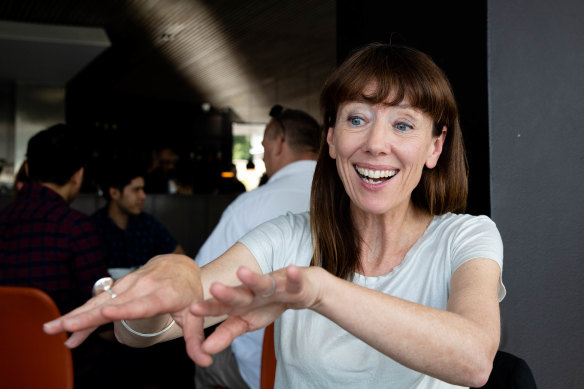
Architect Rachel Neeson at one of her favourite restaurants, the Malaya.Credit: Janie Barrett
"It will be one of the great public indoor rooms of Sydney," the architect tells me. What are the others? "Well, the Town Hall obviously, the public spaces in the Mint, our theatres, galleries." Also central to the revitalisation was the repositioning of the central staircase, which now looks out through a massive window towards St Mary's Cathedral and the Macquarie Street ridge lined with other historic sandstone buildings: Hyde Park Barracks, the Mint, State Parliament and the Mitchell Library.
"That was Joe's idea," Neeson says. "It was absolutely the right thing to do. There are only two main lifts and we needed to encourage people to use the stairs, which then connect you to the city and make you realise that you are at the Australian Museum. In Sydney. It's a great privilege to be able to transform something for the public."
Neeson says she cannot understate the contribution of the museum to the design, particularly during the evolution of the brief: "[Director] Kim [McKay] is a human whirlwind. She achieves things faster than anyone we know. There was a big breakthrough moment when Kim realised that the best way to get the project happening would be to close the museum during the building work."
This reduced the complexities of juggling public access with building headaches such as dust and vibration.
The museum also agreed to the levelling of floors and removal of walls and a mezzanine floor in a building that had evolved since its founding in 1827. "We didn't think they would be so brave," exclaims Neeson.
The confusing former layout of the museum has been remedied with back-of-house offices and workshops shunted to higher levels, out of the way of visitors. The commitment to accessibility has been solved with a "gracious" graded walkway that also allows a bird's-eye view of the all-important shop. The cloaking area on the lower ground floor, glammed up with stylish terrazzo, minimises queues in the entrance hall and maximises the impact of a visitor's arrival in the Grand Hall, the new exhibition area and the adjacent historic galleries (untouched in this refurbishment).
"It's Australia's first museum so we thought, 'let's get the public to those spaces.' We also needed to make a visit easy, so they would come back again."
There are deliberate glimpses of the building's past lives, such as a chunk of an exposed concrete slab from around 1958.
'I think back and wonder: how did I do all that? If I didn't have small children I could have hidden under a rock.'
Rachel Neeson on the loss of her husband
"So for anyone who is vaguely interested in concrete, this is fascinating; the mix they used at that time was quite special and quite sustainable for its era," says Neeson. A convict-built drain, discovered under the basement, is now visible via a peephole.
Today, the Malaya is offering only a set price banquet, with a choice of three entrees and four main courses. The "top favourite" for Neeson is otak otak, white fish minced with chilli and spice, wrapped in a banana leaf and barbecued. When it arrives, she delicately demonstrates how to unfold the parcel for our photographer.
Salt and pepper cauliflower, chicken satay, kapitan prawns, Szechuan eggplant, asparagus stir-fried with honey peas and shredded Chinese mushrooms and beef rendang fill out her order – clearly this is way too much food for two women conducting an interview over lunch. But it's all delicious and no surprise that eventually Neeson will return home to Bronte with a doggy bag for her 13-year-old daughter Alice ("she'll love it!")
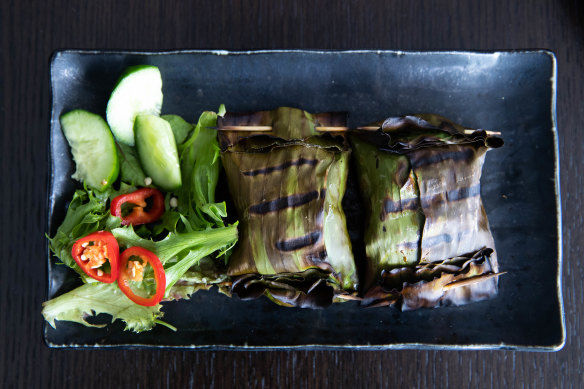
A favourite dish: otak otak parcels of minced white fish with chilli.Credit: Janie Barrett
An exuberant and stylish woman, Neeson had an unconventional upbringing. Of her parents, Ian and Karla, she says: "they are great adventurers; they weren't held down by a strong sense of norms. They also got quite radical after they had me and we went to England on a one-way ticket – we lived in a commune!
"There were 16 other people and I was the only child. There was a roster so the adults cooked once a fortnight. It was organised but with a relaxed hippie vibe. I only remember one debauched party. I do remember, though, that when my sister, Kate, was born, the woven bassinet didn't arrive in time so she had to sleep on a pillow in a cardboard box."
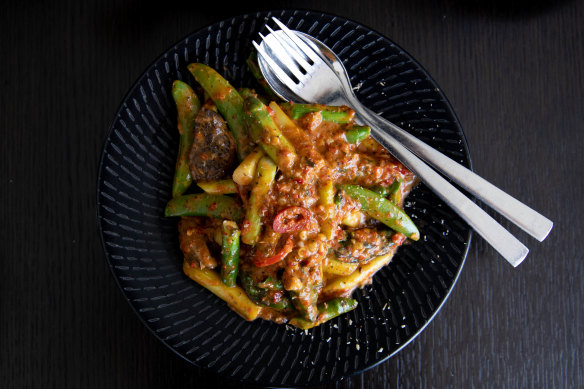
Kerabu asparagusCredit: Janie Barrett
Karla, a nurse, and Ian, an electrician, also invested in a Kombi van and – funds permitting – would travel around Europe. Their young daughter was in charge of selecting camping grounds: "So I was in and out of school all the time and learned to make friends very quickly. And I learnt to understand places."
With the addition of a baby brother born in Canada, the family returned to Sydney, and Summer Hill, when Neeson was nine. "But it probably wasn't really a return to normal life ... my grandparents lived next door. The telephone and the living room were in there. But it was kinda cool. There was always someone when I came home from school." It wasn't until the end of Neeson's first year studying architecture at the University of Sydney that her "parents moved 600 metres south to a red brick suburban and had the first experience of being more like a normal family".
Clearly a source of both great love and amusement, her parents have continued to avoid being a "normal family". Their house is now extended courtesy of an early design by their daughter. Neeson, a fine storyteller, has affectionate stories galore, such as how during the 2000 Olympics, her parents billeted a Kazakhstan boxing official psychologist who didn't speak a word of English."My mother researched what people in Kazakhstan ate for breakfast and bought a huge bag of oats!"
Later, they invited a recently bereaved 88-year-old man to move in, rather than continue in a nursing home. "He had a tear in his eye and had told them, 'I really don't want to go back to that place' and my Dad said, 'you don't have to. We've talked about it. We'd like you to come and live with us.' When it was his 90th birthday, the extended Neeson family came from all over the world to celebrate! He stayed with them until he died."
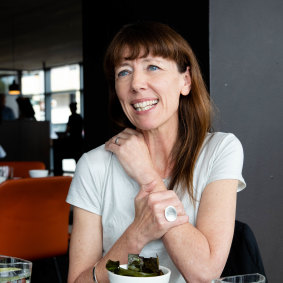
Rachel Neeson at lunch with the author.Credit: Janie Barrett
Less surprisingly, Neeson and her two young children moved back in with her parents 10 months after she was widowed and fearing bankruptcy and the loss of her Bondi home. "Nick was sick, knowingly, for eight and a half months, but it was probably longer," she says.
"I think back and wonder: how did I do all that? There's a lot of adrenaline, I guess. If I didn't have small children, I could have hidden under a rock. But the next day, there is a toddler to feed who can't speak."
Murcutt died before their "lucky break" was completed — their first big public project, the Prince Alfred Park Pool near Central. Since then, Neeson's projects have included the Kempsey-Crescent Head Surf Club, the Juanita Neilsen Community Centre in Woolloomooloo, the Crystal Hall at the Australian Museum and a number of Catholic schools, including the redevelopment at her old school, Bethlehem College in Ashfield. ("We got to select which building to demolish. It was not the worst building but was the building in the strategically worst position".)
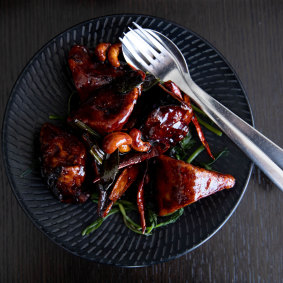
Szechuan eggplant at the Malaya.Credit: Janie Barrett
It was during a "vibrant, vibrant time" at the University of Sydney, where she learnt to "appreciate the elemental and life's truest values", Neeson met both Nick Murcutt and her current partner, Stephen Neille, who subsequently moved to Western Australia, where he worked as an academic for 22 years.
"It is amazing to have the capacity to fall in love a second time," she says, comparing it to the ability of parent to love more than one child. "I had thought that I had my time and that was OK but then Stephen came along and snuck into my life. (And, no surprise, moved into her parents' place with her during the renovation of their new family home. "They were ready for us to move out but wanted him to stay!")
Nick, as her first husband and the father of her children, is still very much part of Neeson's conversation and daily life. Telling an anecdote about birthdays, she remarks, "if Nick was still alive, he'd say every birthday is worth celebrating exponentially because you're lucky to be alive". Talking about her affection for the Malaya, she says, "sometimes we have a reunion memorial for Nick here".
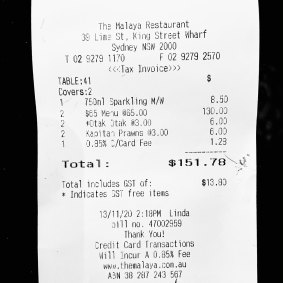
The bill for lunch.Credit: SMH
The fact that her practice is called Neeson Murcutt + Neille underlines the importance of these two personal and professional partnerships. Today, with a team of 15 and increasing recognition, the architects are able to be selective about which projects they take on.
Neeson is bubbling with excitement about a current development at Barker College on the upper North Shore that includes five indoor basketball courts complemented by respite areas where "reticent", less sporty kids can take refuge. "We built an indoor vanishing point ... whee! That place is pumping."
This is a profession that you can live and breathe, says Neeson, who rises early and often walks to their Potts Point office so she can ensure being home with her children at the end of the day. "You have to approach any project with authenticity, otherwise you come across as a fake." Not a word that would seem to apply to this lunch companion.
The Malaya
39 Lime St, King Street Wharf, Darling Harbour
9279 1170
Lunch, Wednesday to Sunday, from 12 noon; Dinner, Wednesday to Sunday, from 6pm